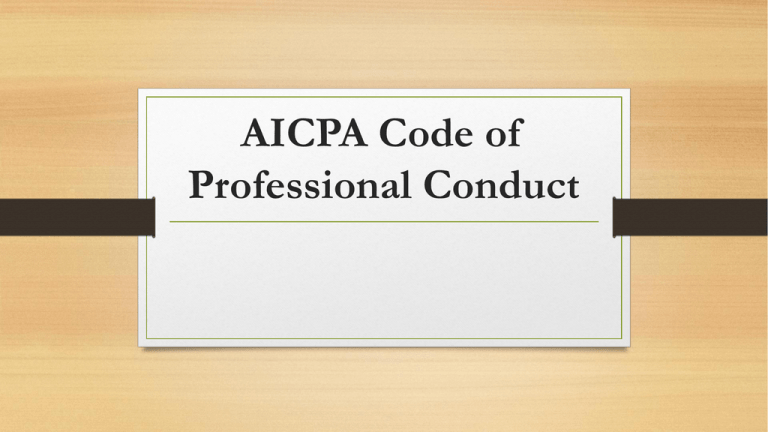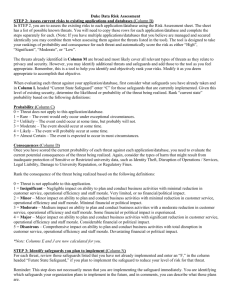AICPA Code of Professional Conduct
advertisement

AICPA Code of Professional Conduct Professional Responsibilities • CPAs have responsibilities to: • The public—relies on CPAs to monitor and enforce standards of fairness and reliability of financial reporting • Clients—rely on CPAs to provide accurate, fair and useful advice, while maintaining confidentiality of client information • Colleagues—CPAs have responsibility to cooperate with one another to improve the art of accounting, maintain the public’s confidence, and carry out the profession’s special responsibilities for self-governance The Public Interest • CPAs have special responsibilities to protect the collective well-being of the community of people and institutions served by the profession: • Clients • Creditors • Governments • Employers • Investors • Business and Financial community • Others Overriding Responsibility • “Unswerving commitment to honorable behavior, even at the sacrifice of personal advantage.” Principles • Integrity → How does the requirement of client confidentiality potentially restrict a CPA’s actions with regard to integrity? • Objectivity & Independence → How does independence affect objectivity? → Difference between actual and apparent independence? • Due Care → How does one assure competence? Be Aware of “Threats” • CPAs must recognize potential threats and consider appropriate safeguards. • • • • • • • Adverse interest threat Advocacy threat Familiarity threat Management participation threat Self-interest threat Self-review threat Undue influence threat “Safeguards” • Three types of safeguards • External Safeguards—created by profession, legislation or regulation • Client-created safeguards (not useful to protect against threats unless operating in combination with other safeguards • Self-imposed safeguards RRC In-class assignment • You are a partner in RRC LLP, a global public accounting firm with offices in 40 states in the U.S. and in 10 countries outside the U.S. Your firm audits two clients in the same industry, one significantly larger than the other. • The larger of these two clients is preparing a takeover bid to purchase the smaller one. It has engaged a team in your firm’s tax practice to advise it on valuation and acquisition structure issues. → Identify the threat(s) inherent in this situation. → What safeguards would you recommend to eliminate the threat or reduce it to an acceptable level? What is the Threat to Objectivity and Independence of the Following? • • • • • • Director Positions Offering/Accepting Gifts or Entertainment Misrepresentations in Preparation of Financial Statements or Records Client Advocacy Subordination of Judgment Use of a Third-party Service Provider RRC In-class assignment 2 • You are a partner in RRC LLP, a global public accounting firm with offices in 40 states in the U.S. and in 10 countries outside the U.S. You have primary responsibility for 4 clients. • Your largest client, M-Ron, is responsible for 75% of the audit revenues generated by your individual client base, and takes up approximately the same amount of your billable hours. The other three clients are of roughly equal size. → Identify the threat(s) inherent in this situation. → What safeguards would you recommend to eliminate the threat or reduce it to an acceptable level? Non-attest Services • Performance of non-attest services for an attest client inevitably lead to threats to the CPA’s objectivity and independence. • Such threats may be reduced to an acceptable level if appropriate safeguards are undertaken. → The client and its management must assume all management responsibilities, including assigning a competent person to oversee the service, evaluation of the adequacy and results of such services, and accepting responsibility for the results of the services; → The CPA establishes in writing an understanding with the client regarding: Objectives of the engagement; Services to be performed; Client’s acceptance of its responsibilities (per above); CPA’s responsibilities; and very importantly Any limitations of the engagement. Which of the following would not, in most circumstances, create an unacceptable threat toforindependence? Valuation services provided solely tax purposes (i.e., valuation of goodwill for tax A purposes) B Provision of expert witness services for an attest client engaged in a competitor. C Design of an attest client’s financial information system (services consulting practice of the audit firm). D Representation of an attest client in the Tax Court. legal dispute with a provided by the





